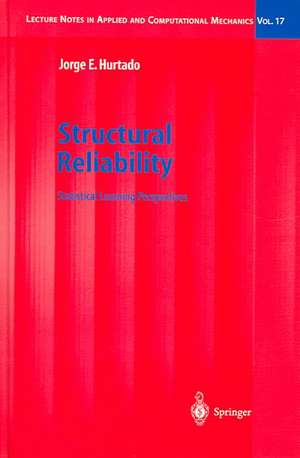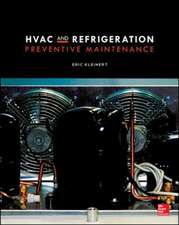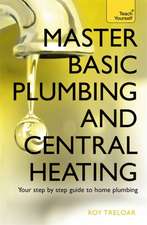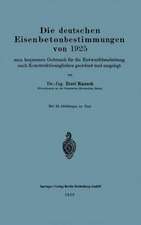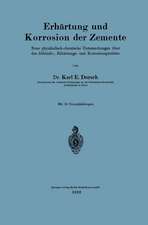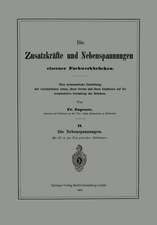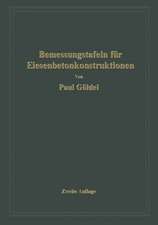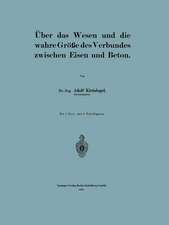Structural Reliability: Statistical Learning Perspectives: Lecture Notes in Applied and Computational Mechanics, cartea 17
Autor Jorge Eduardo Hurtadoen Limba Engleză Hardback – 13 mai 2004
| Toate formatele și edițiile | Preț | Express |
|---|---|---|
| Paperback (1) | 943.43 lei 6-8 săpt. | |
| Springer Berlin, Heidelberg – 20 iul 2012 | 943.43 lei 6-8 săpt. | |
| Hardback (1) | 949.55 lei 6-8 săpt. | |
| Springer Berlin, Heidelberg – 13 mai 2004 | 949.55 lei 6-8 săpt. |
Din seria Lecture Notes in Applied and Computational Mechanics
- 19%
 Preț: 422.95 lei
Preț: 422.95 lei - 18%
 Preț: 1008.12 lei
Preț: 1008.12 lei - 18%
 Preț: 1120.18 lei
Preț: 1120.18 lei - 20%
 Preț: 560.82 lei
Preț: 560.82 lei - 18%
 Preț: 948.16 lei
Preț: 948.16 lei - 24%
 Preț: 1567.86 lei
Preț: 1567.86 lei - 15%
 Preț: 643.65 lei
Preț: 643.65 lei - 18%
 Preț: 956.81 lei
Preț: 956.81 lei - 18%
 Preț: 957.62 lei
Preț: 957.62 lei - 15%
 Preț: 649.87 lei
Preț: 649.87 lei - 18%
 Preț: 1224.54 lei
Preț: 1224.54 lei - 18%
 Preț: 956.50 lei
Preț: 956.50 lei - 18%
 Preț: 954.45 lei
Preț: 954.45 lei - 18%
 Preț: 948.92 lei
Preț: 948.92 lei - 15%
 Preț: 644.49 lei
Preț: 644.49 lei - 18%
 Preț: 1234.62 lei
Preț: 1234.62 lei - 18%
 Preț: 777.69 lei
Preț: 777.69 lei - 18%
 Preț: 1221.83 lei
Preț: 1221.83 lei - 15%
 Preț: 643.00 lei
Preț: 643.00 lei - 18%
 Preț: 956.33 lei
Preț: 956.33 lei - 15%
 Preț: 640.88 lei
Preț: 640.88 lei - 15%
 Preț: 645.79 lei
Preț: 645.79 lei - 18%
 Preț: 944.99 lei
Preț: 944.99 lei - 18%
 Preț: 956.18 lei
Preț: 956.18 lei - 18%
 Preț: 1236.69 lei
Preț: 1236.69 lei - 18%
 Preț: 953.97 lei
Preț: 953.97 lei - 15%
 Preț: 640.88 lei
Preț: 640.88 lei
Preț: 949.55 lei
Preț vechi: 1157.98 lei
-18% Nou
Puncte Express: 1424
Preț estimativ în valută:
181.69€ • 189.72$ • 150.04£
181.69€ • 189.72$ • 150.04£
Carte tipărită la comandă
Livrare economică 15-29 aprilie
Preluare comenzi: 021 569.72.76
Specificații
ISBN-13: 9783540219637
ISBN-10: 3540219633
Pagini: 276
Ilustrații: XIV, 257 p.
Dimensiuni: 155 x 235 x 20 mm
Greutate: 0.56 kg
Ediția:2004
Editura: Springer Berlin, Heidelberg
Colecția Springer
Seria Lecture Notes in Applied and Computational Mechanics
Locul publicării:Berlin, Heidelberg, Germany
ISBN-10: 3540219633
Pagini: 276
Ilustrații: XIV, 257 p.
Dimensiuni: 155 x 235 x 20 mm
Greutate: 0.56 kg
Ediția:2004
Editura: Springer Berlin, Heidelberg
Colecția Springer
Seria Lecture Notes in Applied and Computational Mechanics
Locul publicării:Berlin, Heidelberg, Germany
Public țintă
ResearchCuprins
1 A Discussion on Structural Reliability Methods.- 1.1 Performance and Limit State Functions.- 1.2 Methods Based on the Limit State Function.- 1.3 Transformation of Basic Variables.- 1.4 FORM and SORM.- 1.5 Monte Carlo Methods.- 1.6 Solver Surrogate Methods.- 1.7 Regression and Classification.- 1.8 FORM and SORM Approximations with Statistical Learning Devices.- 1.9 Methods Based on the Performance Function.- 1.10 Summary.- 2 Fundamental Concepts of Statistical Learning.- 2.1 Introduction.- 2.2 The Basic Learning Problem.- 2.3 Cost and Risk Functions.- 2.4 The Regularization Principle.- 2.5 Complexity and Vapnik-Chervonenkis Dimension.- 2.6 Error Bounds and Structured Risk Minimization.- 2.7 Risk Bounds for Regression.- 2.8 Stringent and Adaptive Models.- 2.9 The Curse of Dimensionality.- 2.10 Dimensionality Increase.- 2.11 Sample Complexity.- 2.12 Selecting a Learning Method in Reliability Analysis.- 3 Dimension Reduction and Data Compression.- 3.1 Introduction.- 3.2 Principal Component Analysis.- 3.3 Kernel PCA.- 3.4 Karhunen-Loève Expansion.- 3.5 Discrete Wavelet Transform..- 3.6 Data Compression Techniques..- 4 Classification Methods I — Neural Networks.- 4.1 Introduction.- 4.2 Probabilistic and Euclidean methods.- 4.3 Multi-Layer Perceptrons..- 4.4 General Nonlinear Two-Layer Perceptrons.- 4.5 Radial Basis Function Networks.- 4.6 Elements of a General Training Algorithm.- 5 Classification Methods II — Support Vector Machines.- 5.1 Introduction.- 5.2 Support Vector Machines.- 5.3 A Remark on Polynomial Chaoses.- 5.4 Genetic Algorithm..- 5.5 Active Learning Algorithms.- 5.6 A Comparison with Neural Classifiers.- 5.7 Complexity, Dimensionality and Induction of SV Machines.- 5.8 Application Examples.- 5.9 An Application to Stochastic Stability.- 5.10 Other KernelClassification Algorithms.- 6 Regression Methods.- 6.1 Introduction.- 6.2 The Response Surface Method Revisited.- 6.3 Neural Networks.- 6.4 Support Vector Regression.- 6.5 Time-Dependent MLP for Random Vibrations.- 7 Classification Approaches to Reliability Indexation.- 7.1 Introduction.- 7.2 A Discussion on Reliability Indices.- 7.3 A Comparison of Hyperplane Approximations.- 7.4 Secant Hyperplane Reliability Index.- 7.5 Volumetric Reliability Index.- References.- Essential Symbols.
Recenzii
From the reviews:
"The methods presented and exemplified in the book are what in the statistical world would be called nonlinear and nonparametric regression or pattern recognition techniques … . The book is written from an algorithmic perspective … . the book is a valuable overview of problems and techniques used in structural safety analysis." (Georg Lindgren, Mathematical Reviews, Issue 2006 h)
"The methods presented and exemplified in the book are what in the statistical world would be called nonlinear and nonparametric regression or pattern recognition techniques … . The book is written from an algorithmic perspective … . the book is a valuable overview of problems and techniques used in structural safety analysis." (Georg Lindgren, Mathematical Reviews, Issue 2006 h)
Textul de pe ultima copertă
This monograph presents an original approach to Structural Reliability from the perspective of Statistical Learning Theory. It proposes new methods for solving the reliability problem utilizing the recent developments in Computational Learning Theory, such as Neural Networks and Support Vector machines. It also demonstrates important issues on the management of samples in Monte Carlo simulation for structural reliability analysis purposes and examines the treatment of the structural reliability problem as a pattern recognition or classification task. This carefully written monograph is aiming at researchers and students in civil and mechanical engineering, especially in reliability engineering, structural analysis, or statistical learning.
Caracteristici
Original approach to structural reliability from the perspective of statistical learning theory
